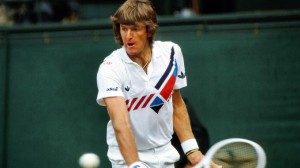By Randy Walker
@TennisPublisher
It took 30 years, but Kevin Curren finally got his wish.
Well, sort of.
On August 29, 1985, Curren, the No. 5 seed at the US Open, crashed out in the first round on the Grandstand Court, falling in straight-sets to an up-and-coming 20-year-old Frenchman Guy Forget.
Curren was fresh off an impressive runner-up stretch at Wimbledon where he blitzed both John McEnroe and Jimmy Connors in straight sets before losing a four-set final to a 17-year-old future Hall of Famer Boris Becker. Curren, obviously in a fit of agitation after his upset-loss to Forget, turned his post-match press conference into an epic rant at the then seven-year-old USTA National Tennis Center, the city of New York and the US Open.
“I hate the city, the environment and Flushing Meadow,” Curren said. “There is noise, the people in the grandstand are never seated and it takes an hour and a half in traffic to get here. It’s sickening that with all the money they get from TV, the USTA doesn’t build a better facility. The USTA should be shot. And they should drop an A-bomb on the place.”
Fast forward 30 years to 2015 and the USTA National Tennis Center is now in its last throws of its former identity that scoured Curren and other less vocal tennis players and fans. Fortunately, nuclear war was needed for this significant transformation over three decades to the facility now named for the effervescent and refreshing Billie Jean King.
The former concrete jungle, hastily but incredibly constructed in a year in time for the 1978 U.S. Open is now rehabilitated and matured into a pleasant and modern tennis playground complete with grass, gardens, flowers and fountains – making it a comfortable place to play tennis as well as for fans to see and be seen.
The Grandstand court where Curren lost – and not exactly enjoyed – will be used for the last time in 2015 before it is imploded and made into office and hospitality space. A new Grandstand is rising on the southwest corner of the grounds, to seat 8,000 fans, for the 2016 US Open. The adjacent Louis Armstrong Stadium, which Curren aspired to be playing on in a U.S. Open final back in the day, will start to undergo a second overhaul, moving to gain a roof in time for the 2017 U.S. Open after it ceased to become the tournament’s Center Court after the 1996 tournament. Arthur Ashe Stadium, which debuted in 1997, now looks like a space-ship out of a new “Star Wars” movie, with its steel beams crossing its top, one year away from being a full-functioning roofed stadium. The grounds, while still crowded in the food court and field courts as the popularity of the event continues to gain, will also be spread out in the years to come to better accommodate the throngs of fans who make their Flushing pilgrimage each year.
Curren was not heard much from following his 1985 season, never seriously threatening to win a major singles title. Mike Conklin of the Chicago Tribune wrote that Curren’s criticisms at the 1985 US Open were “a bite out of the Big Apple…enough make Mayor Ed Koch wince.” However, curious minds would be interested in hear of his updated thoughts on the new home for the U.S. Open, transformed by non-nuclear means.

